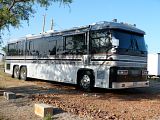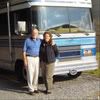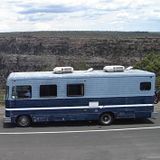Go to...  | Start A New Topic  | Search  | Notify  | Tools  | Reply To This Topic  |  |
 |
On our 88 SE tag there is an in fuel line device located on the frame just behind the duals on the passenger side of the coach. It is visible by looking at the frame from the wheel and has a hole in the frame which has been provided for its installation. Last weekend we smelled gas and traced it to this device which was seeping. GM does not list this part available anymore. There is a GM part number - 15598336 available as a Workhorse cross over part for approximately $200.00. With the help of a kind parts man I found Holley part #12-803 for $30.00 or the Holly repair kit #12-807 for $7.00 The Holly part is identical in apperance to the original and is easily installed.  [This message has been edited by davebowers (edited May 30, 2005).] | ||
|
What is the purpose of this "devise"? "THE TOY" 88 33'Regal SE Coach #3448 | ||||
|
 |
The guy at the GM store tells me its to regulate the fuel pressure created by an "in tank" electric fuel pump which assists the fuel pump on the engine in delivering all that gas all that way forward from the rear tank. I have not previously been aware of an electric fuel pump in the gas tank and still wonder why it can not be heard ticking away when the ignition is turned on. | |||
|
| First Month Member |
Some of them are pretty quiet. Stick a screwdriver blade against the bottom of the tank and have someone turn the ignition on and off while the end of the handle is pressed against your ear. You should hear a whirring sound. | |||
|
Hey Dr. bill h, As a kid fifty million years ago my dad used to do the screw driver trick to his ear. One time after WWII when new cars were hard to get he installed a ton of crate motors in Buicks. Well they came with the dip stick along with other items and after he had installed the engine in one and added the oil he heard a TICK. By mistake he had inserted the old dip stick in the engine. With the engine running and with a screw driver to his ear he moved such around the block and finally touched the dip stick, and WOW there it was. The old dip stick was bent and was touching the crank. At one time he had 119 new crate engines lined up in the garage ready to install. The shop had a wood floor and oh how I loved to run with a creeper and belly flop like I was on a sled. Loved the noise it made on the wood floor. The office people on the floor below DIDN'T though, but I was the owners KID... hehehe I must have been a real jerk. Don't say it ron..... Fun is Good | ||||
|
 6/12 6/12Formally known as "Humbojb"  |
I too smell fuel sometimes and after lifting the doghouse cover, know it's not coming from the engine. On my 73 fuel injected Volvo, there is a fuel pressure regulator and there are specs that it must be set to. Does anyone know what the correct fuel pressure should be for a 454 carburated engine? | |||
|
| First Month Member |
The Quadrajet runs well with only 2 to 3 psi. A mechanical pump will often put out as much as 6 or 7 psi at idle. With electric pumps, I set my regulators at 4 lbs. | |||
|
Hey I need that fuel pressure regulator aslo for my 1988 southwind. But the Holley part #12-803 is with a psi from 4 to 9. Are these engines not fuel injected? is so then this part would not work. Right? | ||||
|
 3/23 3/23 |
1988,, pretty sure it has a carburetor, unless A PO upgraded to Fuel injection. Don't know your engine but 3-8 PSI is usually right. Fuel injection is in the neighborhood of 50 PSI, check your unit specs. 1971 24 ft Barth Continental P30 chassis 350 engine | |||
|
Official Barth Junkie |
Early motorhomes with fuel tanks in the rear and gasoline engines in the front have always been subject to fuel delivery problems and vapor lock on hot days. The earliest versions had a mechanical fuel pump mounted low on the engine. Two problems: long suction line and hot engine bay. Very prone to vapor lock. Later versions (early 80's) used a boost pump in the rear to push fuel to the forward pump. Some intank, some frame mounted. Much better. About then many started using a pressure regulator to provide ample, but not excessive fuel pressure to the carb. By late 80's many were using return lines to keep fuel circulating and cooler in the lines. Engine fuel pumps had supply port, output to carb and a return line back to the tank. Carbs liked 4-6psi typically. By 90's the throttle body fuel injection (TBI) systems were used. These used low pressure injectors mounted where the carb had been. GM stayed with intank pumps but upgraded to higher pressures, around 18-20psi. This pressure sent fuel forward to the fuel pressure regulator in the injector body. The regulator supplied steady 11-13psi to the injectors, the rest was returned to the tank. The engine driven fuel pump was eliminated entirely. The newest units have multiport injection with much higher pressures ie 50-70psi. These are very reliable and well designed. As for inline regulators, they were mostly used for carburetor systems. Carbs work best around 4-6psi. Higher and they may overfill the float bowl and waste gas. Lower, more vapor lock and the big V8s will show fuel starvation under high throttle conditions. The closer the regulator is to the carb inlet the better. Always route the fuel lines as far as possible from heat sources, engine and exhaust. Be sure to check flex lines often and use only ethanol rated hose. 9708-M0037-37MM-01 "98" Monarch 37 Spartan MM, 6 spd Allison Cummins 8.3 325+ hp | |||
|
 |
that is in the timeframe of EFI being introduced to the RV chassis vehicles. If you have a Chevrolet chassis, the engine code W means you have a 454 with a carburetor. There is a chance you have EFI, please check the VIN for engine code, so you can tell what engine type was originally there, and it can be compared to what you have now. Or just take off the air cleaner and post a picture of what you see!!!! happy motoring, Matt 1987 Barth 27' P32 Chassis Former State Police Command Post Chevrolet 454 Weiand Manifold, Crane Cam, Gibson Exhaust | |||
|
| Powered by Social Strata |
| Please Wait. Your request is being processed... |
|
This website is dedicated to the Barth Custom Coach, their owners and those who admire this American made, quality crafted, motor coach.
We are committed to the history, preservation and restoration of the Barth Custom Coach.
We are committed to the history, preservation and restoration of the Barth Custom Coach.

